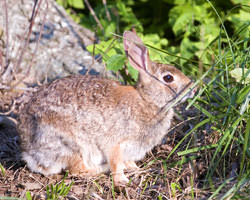

Courtesy Hemera/Thinkstock
Use wire mesh to keep wild rabbits from enjoying a lunch from your garden.
As you begin to salivate over the luscious tomatoes and crispy peppers you’ll soon have growing in your garden, think about how you can get the fruits of your labor to the dinner table unblemished. While starting plants from seed and defending against disease are hurdles to successful gardening, wildlife in the garden can present a challenge all its own.
“Often, we plant gardens to attract birds and butterflies; however, other wildlife may be annoying,” says Nancy Pollard, a horticulture educator at the University of Illinois Cooperative Extension. “Rabbits nip off tender shoots or girdle the bark of young trees; squirrels eat food intended for birds and nip off buds and branches; skunks dig in the yard, raid garbage and leave a memorable musk when frightened.”
Uninvited wildlife is attracted by food, water and shelter. Bird feeders, trash cans with lids easy to remove and pet food left outside overnight offer a smorgasbord that unintentionally invites wildlife into your garden.
Pollard offers some tips for co-existing peacefully with wildlife.
“Animals, like humans, are creatures of habit,” she says. Upon observing landscape harm, take steps immediately to prevent further damage before the animals’ habits become firmly ingrained. “Discouraging damaging habits usually requires multiple strategies.”
Rabbits
In a small garden, you can exclude rabbits using a wire-mesh fence with holes 1 inch or smaller; to prevent burrowing under the fence, bury the mesh 6 inches deep. To do this, purchase a 4-foot-wide mesh roll, and bend the bottom 6 inches outward. This allows for 3 feet of fence above ground. You can also protect trees with cylinders made from wire mesh that has 1/4-inch by 1/4-inch holes. The smaller-sized holes guard against mice, as well. Keep in mind gates provide entry points for rabbits as well as people.
Squirrels
Wildlife experts recommend using a 2-foot-wide metal collar 6 feet off the ground to keep squirrels from terrorizing isolated trees and poles. To allow for tree-trunk growth, attach the metal collar with wires fastened together with springs.
“Squirrels can jump 8 feet, so this only works on isolated trees,” says Pollard. “Trim back trees to prevent access to roofs and attics. If you have room, provide corn for the squirrels away from the bird feeders to distract them from the feeders. Enjoy their antics.”
Skunks
Even if skunks aren’t rummaging through your vegetable garden, their stench may be apparent, even if they haven’t sprayed. If you have skunks in your yard, keep handy the recipe and ingredients for skunk-odor removal. Mix 1 quart 3 percent hydrogen peroxide solution, 1/4 cup baking soda and 1 teaspoon liquid soap; do not add water. The concoction can be used for washing skin, clothes, dogs and other sprayed items. Note, the peroxide in the solution may lighten the fur of pets.
To find more tips about living with wildlife, visit the the University of Illinois Extension Living with Wildlife website.




